Plougastel (where the strawberries come from)
posted 19 July 2005
On the way home from lunch at Auberge des Glazicks in Plomodiern, we stopped in Plougastel, strawberry capital of France. Except during July and August, the strawberry museum there opens only on a complicated part-time schedule, and we had planned our outing to coincide with a Saturday afternoon when it was open. Unfortunately, when the time came to leave the house, I couldn't locate the little brochure giving its address, but I knew it was near Plougastel and was quite well known, so I was confident it would be heavily sign-posted. Well, it wasn't—probably the only such attraction in France that isn't. But I had seen that brochure on the rack in the lobby of every hotel and restaurant we'd visited, so I proposed that we park by the church in the center of Plougastel and stroll around the town square until we found a hotel and pick up a new brochure. We parked, strolled the 10 steps back to the square, turned the first corner, and there was the museum!
It was an old building set back from the street, with "Museum of the Strawberry" painted on the front, and it looked not just closed but positively abandoned. On closer approach, though, we found a little sign saying "This way to the entrance" and pointing around the side of the building. We started through the uphill passageway between buildings, which was so heavily landscaped that it was like treading a jungle path. Suddently, we heard a loud "Ya-a-a-a-a-h!" and a bicycle turned the corner and came hurtling down toward us. One 12-year-old boy was peddling, and another was riding on the back, arms and legs outstretched, yelling at the top of his lungs in sheer high spirits. We turned sideways and plastered ourselves back against the bushes beside the path, and they applied the brakes hard and skidded to a stop, so a collision was avoided, but the yelling kid changed his tune to "Watch out! Watch out! There's somebody here!" so the second bicycle full of 12-year-olds had a little better braking distance. Behind them came the giggling group of four 12-year-old girls on foot. Once they all got stopped and recovered from their surprise, the manners young French persons are taught kicked in. The boys nodded to us and said gravely, "Good afternoon, madame; good afternoon, sir," before continuing on their way with somewhat more decorum. Very high class of hooligan in that neighborhood.
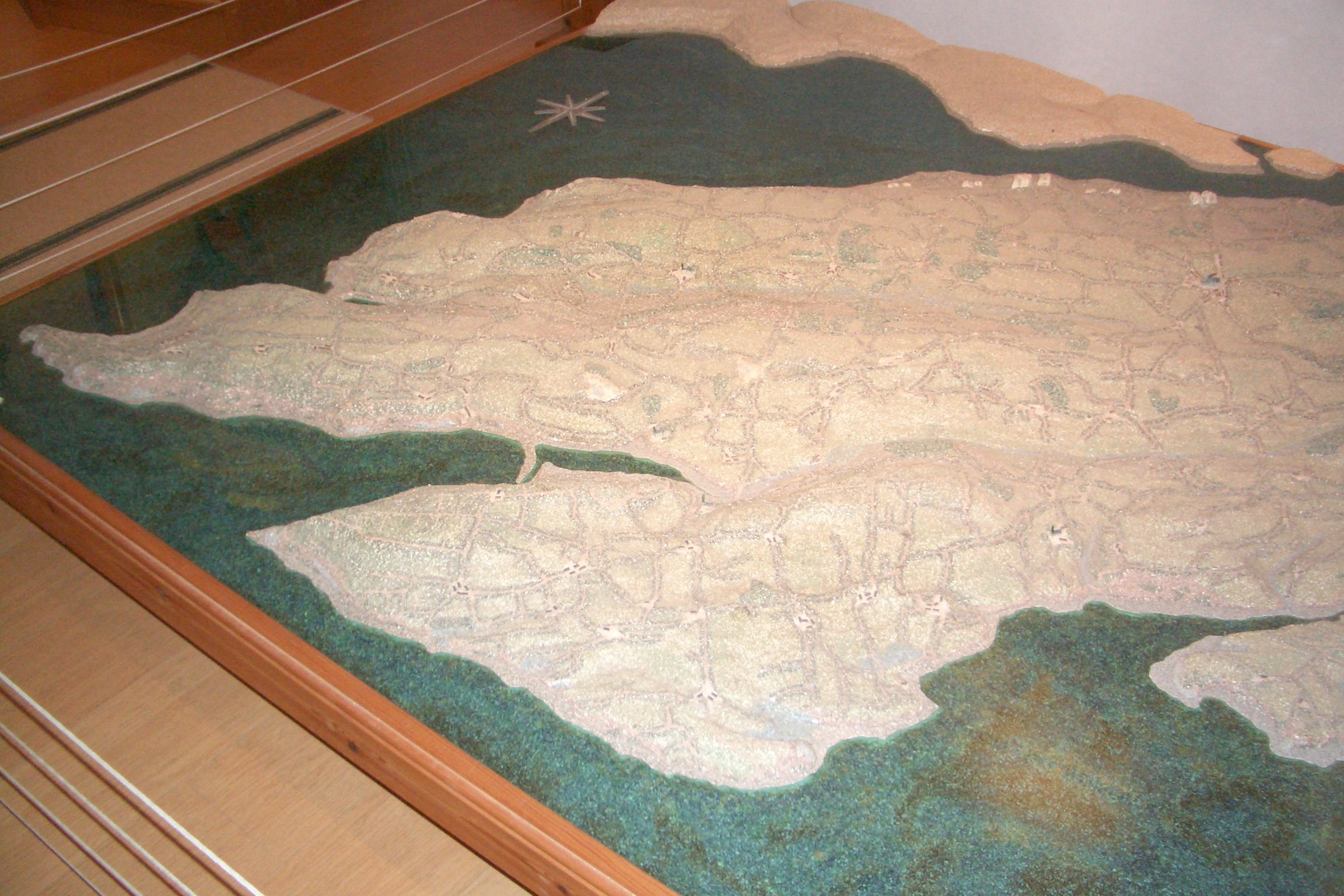 When we finally emerged from the jungle, we found that we had left the quaint and traditional old town square for a space surrounded by glass and steel. Across the street was the modern new Mairie, and the building we had circled, entered through an equally modern lobby, housed not just the strawberry museum but the local art museum and the civic center as well. Inside, a nice young man gave us brochures and waved us cheerfully toward the exhibits—admission was free. We were the only people there. The exhibits were excellent. The covered the history of strawberry cultivation in the area, the evolution of methods from the earliest times to the present, the emergence of cooperatives and farmers' unions, changing markets and strawberry varieties, local dress and customs—everything. We learned that one of the earliest popular varieties of strawberry, a white-fruited strain called "Blanche de Chile," was brought to the area from South America by a guy named "Frézier." In French, the name, cognate with "Fraser" and "Frazier," is a homonym of "fraisier," meaning "strawberry plant." His family seems to have been pretty preoccupied with strawberries, even including them in the family crest. We saw maps, flat and in relief, showing where on the peninsula strawberries have traditionally been cultivated, where different varities do best (and explanations of why, in terms of temperature, humidity, soil type, etc.), and where they are grown today.
When we finally emerged from the jungle, we found that we had left the quaint and traditional old town square for a space surrounded by glass and steel. Across the street was the modern new Mairie, and the building we had circled, entered through an equally modern lobby, housed not just the strawberry museum but the local art museum and the civic center as well. Inside, a nice young man gave us brochures and waved us cheerfully toward the exhibits—admission was free. We were the only people there. The exhibits were excellent. The covered the history of strawberry cultivation in the area, the evolution of methods from the earliest times to the present, the emergence of cooperatives and farmers' unions, changing markets and strawberry varieties, local dress and customs—everything. We learned that one of the earliest popular varieties of strawberry, a white-fruited strain called "Blanche de Chile," was brought to the area from South America by a guy named "Frézier." In French, the name, cognate with "Fraser" and "Frazier," is a homonym of "fraisier," meaning "strawberry plant." His family seems to have been pretty preoccupied with strawberries, even including them in the family crest. We saw maps, flat and in relief, showing where on the peninsula strawberries have traditionally been cultivated, where different varities do best (and explanations of why, in terms of temperature, humidity, soil type, etc.), and where they are grown today.
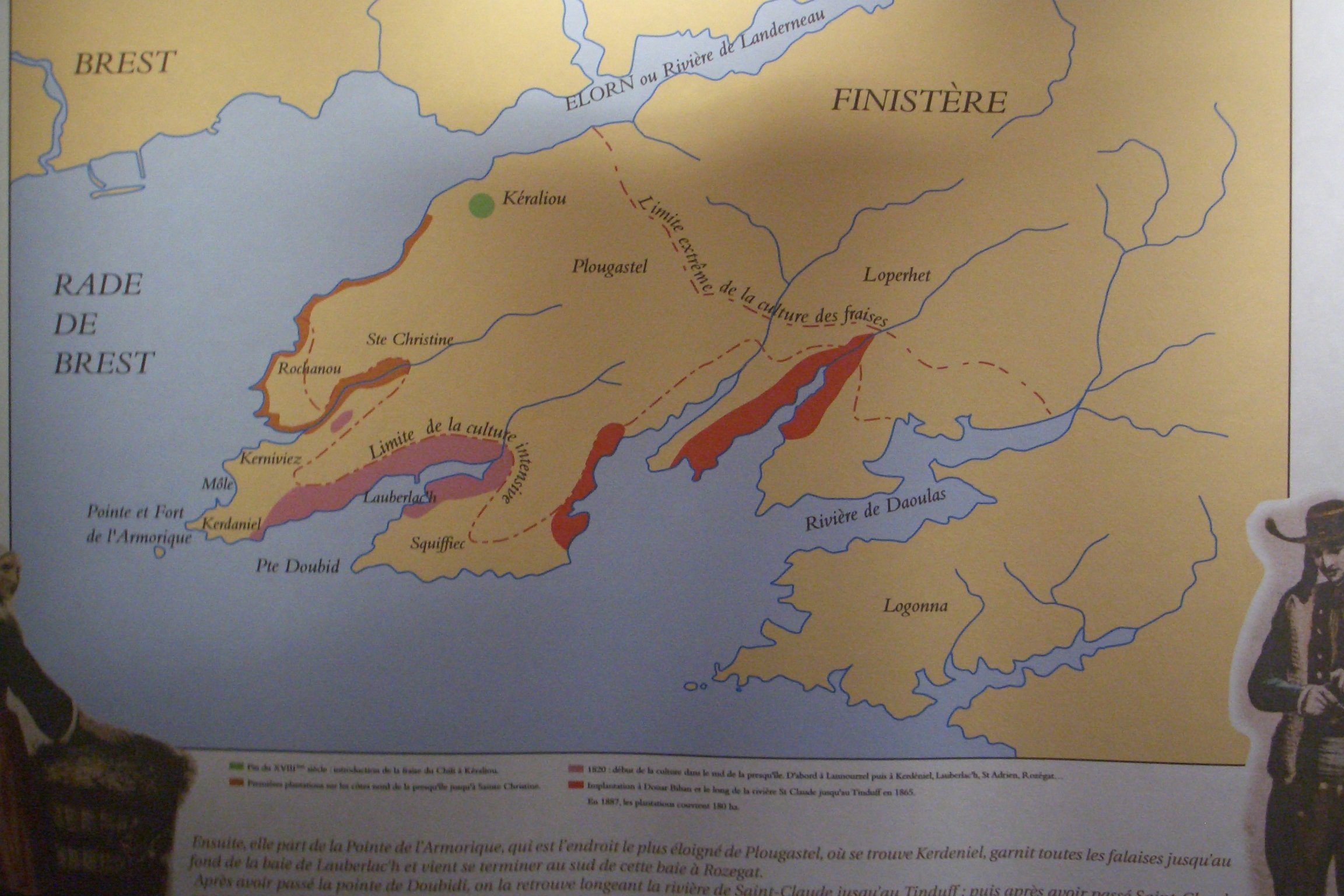 We saw how cultivation evolved from planting in rows in irrigated fields, where men, women, and children habitually worked on their knees during weeding and harvest, through planting in shade-shelters, planting on trestle tables so that harvesters could work standing up, modern green-house cultivation (complete with beneficial insects to control pests), to the modern hydroponic methods (the roots are in a circulating liquid medium at head height, and the leaves and fruit hang down on both sides. We learned that England has always been a major market and that, at times during the 19th century, three steamships a day crossed the channel laden with nothing but Plougastel strawberries (in addition to the many trainloads that left daily for Paris). Production was so high that, in particularly good years, some fields of berries rotted on the ground because the region just didn't have enough people in it to harvest them all. Construction of the bridge between the Plougastel peninsula and Brest revolutionized shipping. Plougastel has no deep-water mooring, so the ships had to anchor offshore, and the berries had to be taken to the beach in carts, then shifted to lighters, which took them out to the ship, where they were shifted from lighter to ship (both of which were tossing up and down, out of phase) by stevedores more concerned with speed than marketability. Once the bridge was built, the berries could be taken directly to the docks in Brest on carts, then walked directly up the gangplank onto the ships by the producers themselves if they wanted. Quality, and therefore selling price, skyrocketed. Production is decreasing now, because modern shipping has brought competition from much farther away, but the Plougastel label is still a well-known mark of quality. The "garriguette" variety (my second favorite after the "maras des bois") was in season while we were there, and they put American commercial strawberries seriously in the shade.
We saw how cultivation evolved from planting in rows in irrigated fields, where men, women, and children habitually worked on their knees during weeding and harvest, through planting in shade-shelters, planting on trestle tables so that harvesters could work standing up, modern green-house cultivation (complete with beneficial insects to control pests), to the modern hydroponic methods (the roots are in a circulating liquid medium at head height, and the leaves and fruit hang down on both sides. We learned that England has always been a major market and that, at times during the 19th century, three steamships a day crossed the channel laden with nothing but Plougastel strawberries (in addition to the many trainloads that left daily for Paris). Production was so high that, in particularly good years, some fields of berries rotted on the ground because the region just didn't have enough people in it to harvest them all. Construction of the bridge between the Plougastel peninsula and Brest revolutionized shipping. Plougastel has no deep-water mooring, so the ships had to anchor offshore, and the berries had to be taken to the beach in carts, then shifted to lighters, which took them out to the ship, where they were shifted from lighter to ship (both of which were tossing up and down, out of phase) by stevedores more concerned with speed than marketability. Once the bridge was built, the berries could be taken directly to the docks in Brest on carts, then walked directly up the gangplank onto the ships by the producers themselves if they wanted. Quality, and therefore selling price, skyrocketed. Production is decreasing now, because modern shipping has brought competition from much farther away, but the Plougastel label is still a well-known mark of quality. The "garriguette" variety (my second favorite after the "maras des bois") was in season while we were there, and they put American commercial strawberries seriously in the shade.
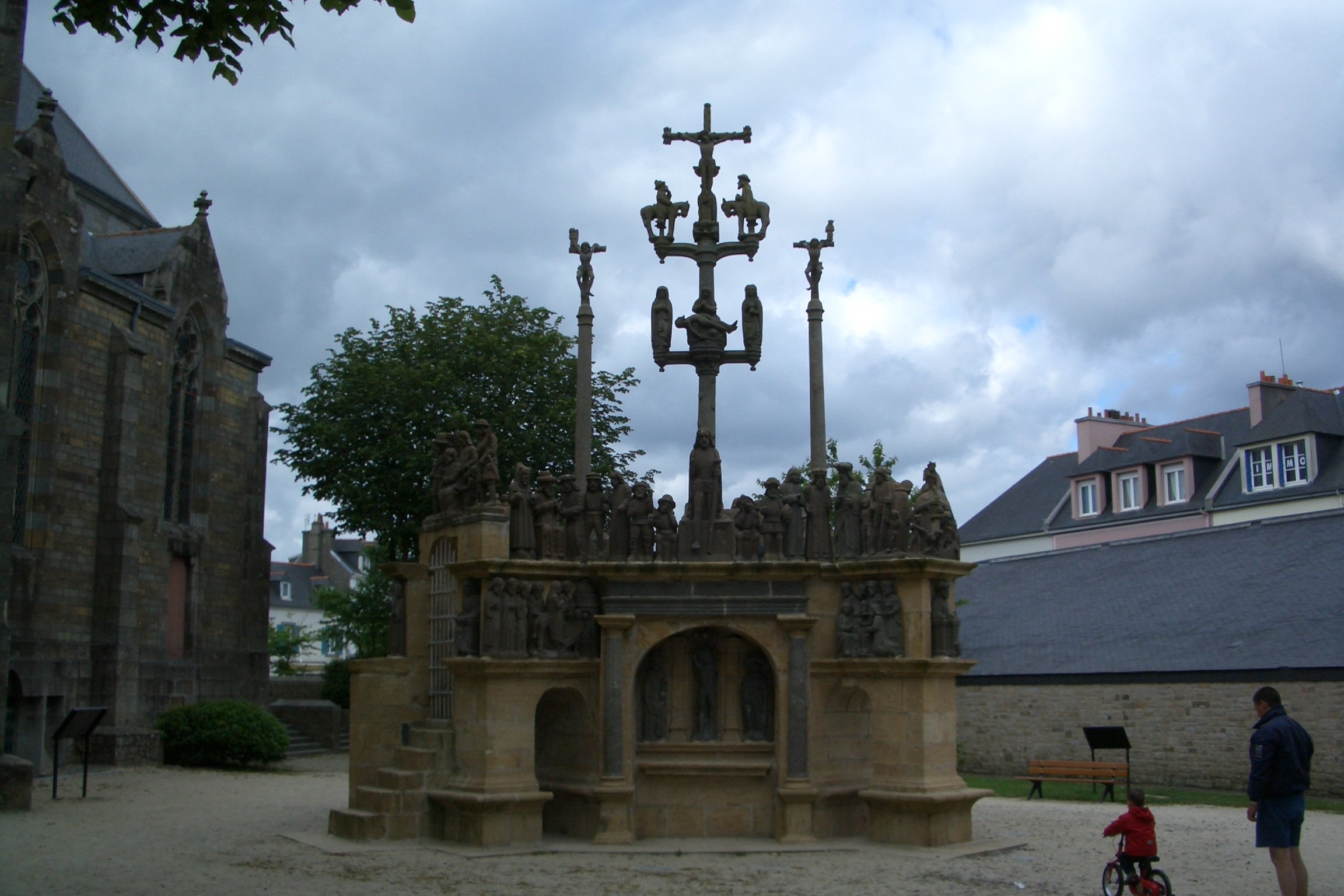 In the lobby, you could buy all manner of strawberry souvenirs and regional postcards, as well as strawberry jam, candy, cookies, and whatnot.
In the lobby, you could buy all manner of strawberry souvenirs and regional postcards, as well as strawberry jam, candy, cookies, and whatnot.
On our way from the car to the square, I had caught a glimpse of a calvaire beyond the church, so on the way back, we walked over to have a look. The Calvaire de Plougastel turns out to be a big deal—one of the most elaborate in Brittany—when we were there, it was certainly drawing more onlookers than the museum. I didn't notice until afterwards that it's the actual example used in the front of the Michelin guide to illustrate the various parts of a calvaire. All around the sides are large illustrated panels identifying the figures and explaining the scenes it depicts
Both the church and the calvaire were leveled by allied bombing during the siege of Brest during World War II. Fortunately, among the first group of American soldiers to arrive on the found afterward was an art-history professor, and he apparently saw at a glance that they had blown up a world-class art treasure. (I would surely have noticed that it was a world-class craft treasure but would probably have been blind to its artistic merits). He was appalled and immediately recruited help to pick up all the pieces. He arranged to have them put under cover and protected from further damage. After the war, back in the U.S., he set up a foundation to collect money for the restoration, and he returned to France in the 1950s to supervise the work. It was recently re-restored with the latest technical advances, and today, you'd never know it had been broken. The complaint today is that, when the church was later rebuilt (in a more modern style than the original), it was doubled in size and tends to dwarf the calvaire.
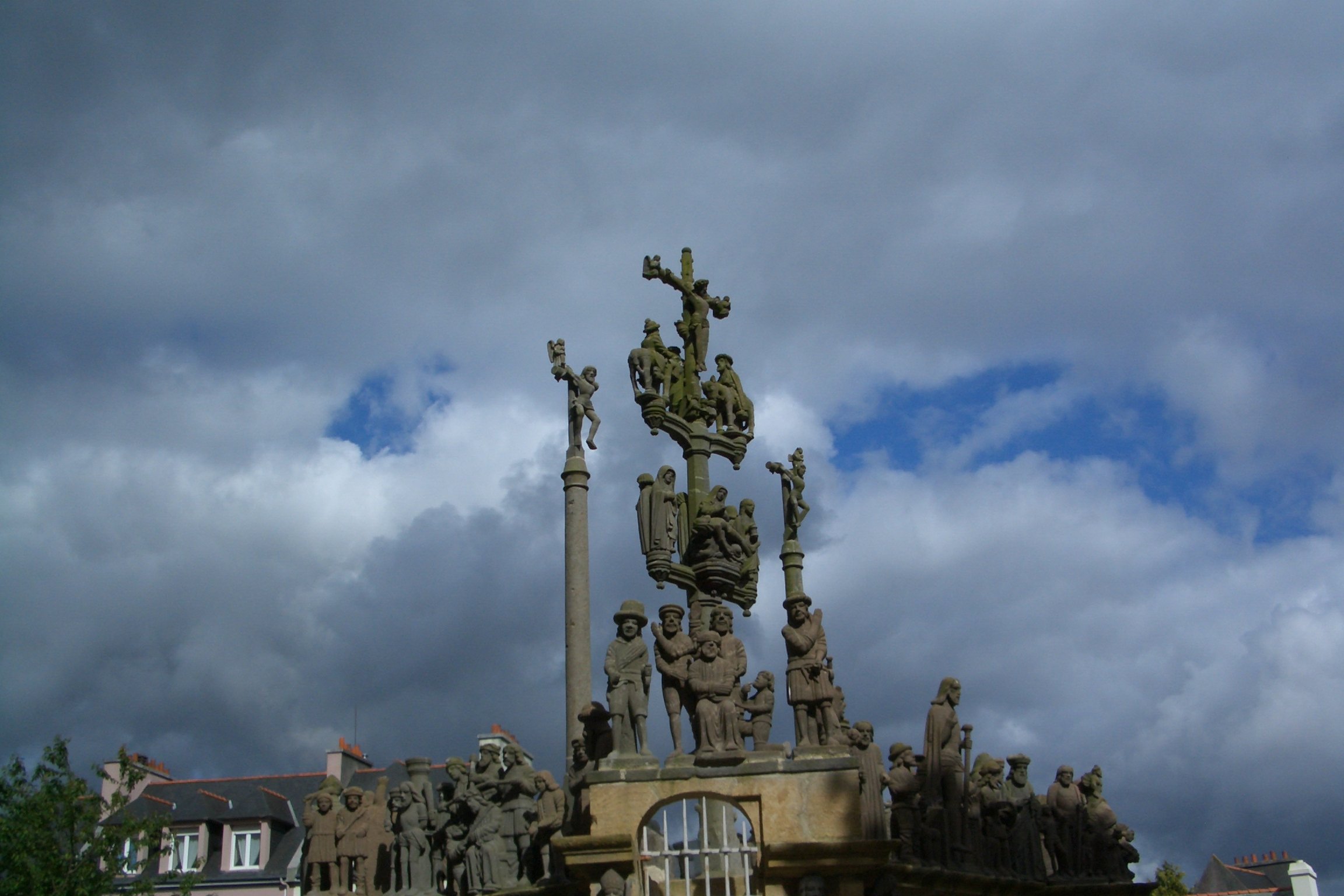 previous entry List of Entries next entry
previous entry List of Entries next entry
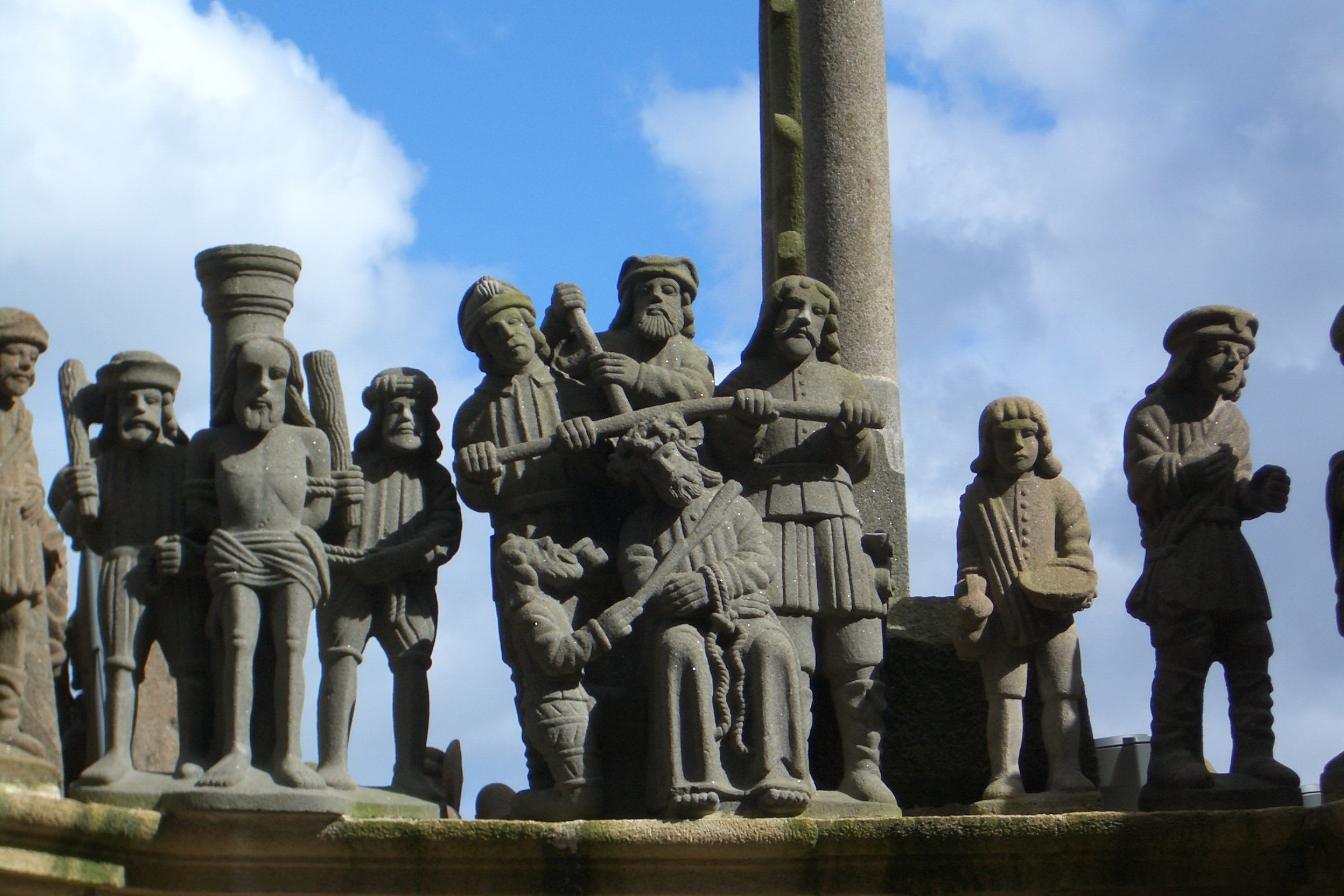
 When we finally emerged from the jungle, we found that we had left the quaint and traditional old town square for a space surrounded by glass and steel. Across the street was the modern new Mairie, and the building we had circled, entered through an equally modern lobby, housed not just the strawberry museum but the local art museum and the civic center as well. Inside, a nice young man gave us brochures and waved us cheerfully toward the exhibits—admission was free. We were the only people there. The exhibits were excellent. The covered the history of strawberry cultivation in the area, the evolution of methods from the earliest times to the present, the emergence of cooperatives and farmers' unions, changing markets and strawberry varieties, local dress and customs—everything. We learned that one of the earliest popular varieties of strawberry, a white-fruited strain called "Blanche de Chile," was brought to the area from South America by a guy named "Frézier." In French, the name, cognate with "Fraser" and "Frazier," is a homonym of "fraisier," meaning "strawberry plant." His family seems to have been pretty preoccupied with strawberries, even including them in the family crest. We saw maps, flat and in relief, showing where on the peninsula strawberries have traditionally been cultivated, where different varities do best (and explanations of why, in terms of temperature, humidity, soil type, etc.), and where they are grown today.
When we finally emerged from the jungle, we found that we had left the quaint and traditional old town square for a space surrounded by glass and steel. Across the street was the modern new Mairie, and the building we had circled, entered through an equally modern lobby, housed not just the strawberry museum but the local art museum and the civic center as well. Inside, a nice young man gave us brochures and waved us cheerfully toward the exhibits—admission was free. We were the only people there. The exhibits were excellent. The covered the history of strawberry cultivation in the area, the evolution of methods from the earliest times to the present, the emergence of cooperatives and farmers' unions, changing markets and strawberry varieties, local dress and customs—everything. We learned that one of the earliest popular varieties of strawberry, a white-fruited strain called "Blanche de Chile," was brought to the area from South America by a guy named "Frézier." In French, the name, cognate with "Fraser" and "Frazier," is a homonym of "fraisier," meaning "strawberry plant." His family seems to have been pretty preoccupied with strawberries, even including them in the family crest. We saw maps, flat and in relief, showing where on the peninsula strawberries have traditionally been cultivated, where different varities do best (and explanations of why, in terms of temperature, humidity, soil type, etc.), and where they are grown today. We saw how cultivation evolved from planting in rows in irrigated fields, where men, women, and children habitually worked on their knees during weeding and harvest, through planting in shade-shelters, planting on trestle tables so that harvesters could work standing up, modern green-house cultivation (complete with beneficial insects to control pests), to the modern hydroponic methods (the roots are in a circulating liquid medium at head height, and the leaves and fruit hang down on both sides. We learned that England has always been a major market and that, at times during the 19th century, three steamships a day crossed the channel laden with nothing but Plougastel strawberries (in addition to the many trainloads that left daily for Paris). Production was so high that, in particularly good years, some fields of berries rotted on the ground because the region just didn't have enough people in it to harvest them all. Construction of the bridge between the Plougastel peninsula and Brest revolutionized shipping. Plougastel has no deep-water mooring, so the ships had to anchor offshore, and the berries had to be taken to the beach in carts, then shifted to lighters, which took them out to the ship, where they were shifted from lighter to ship (both of which were tossing up and down, out of phase) by stevedores more concerned with speed than marketability. Once the bridge was built, the berries could be taken directly to the docks in Brest on carts, then walked directly up the gangplank onto the ships by the producers themselves if they wanted. Quality, and therefore selling price, skyrocketed. Production is decreasing now, because modern shipping has brought competition from much farther away, but the Plougastel label is still a well-known mark of quality. The "garriguette" variety (my second favorite after the "maras des bois") was in season while we were there, and they put American commercial strawberries seriously in the shade.
We saw how cultivation evolved from planting in rows in irrigated fields, where men, women, and children habitually worked on their knees during weeding and harvest, through planting in shade-shelters, planting on trestle tables so that harvesters could work standing up, modern green-house cultivation (complete with beneficial insects to control pests), to the modern hydroponic methods (the roots are in a circulating liquid medium at head height, and the leaves and fruit hang down on both sides. We learned that England has always been a major market and that, at times during the 19th century, three steamships a day crossed the channel laden with nothing but Plougastel strawberries (in addition to the many trainloads that left daily for Paris). Production was so high that, in particularly good years, some fields of berries rotted on the ground because the region just didn't have enough people in it to harvest them all. Construction of the bridge between the Plougastel peninsula and Brest revolutionized shipping. Plougastel has no deep-water mooring, so the ships had to anchor offshore, and the berries had to be taken to the beach in carts, then shifted to lighters, which took them out to the ship, where they were shifted from lighter to ship (both of which were tossing up and down, out of phase) by stevedores more concerned with speed than marketability. Once the bridge was built, the berries could be taken directly to the docks in Brest on carts, then walked directly up the gangplank onto the ships by the producers themselves if they wanted. Quality, and therefore selling price, skyrocketed. Production is decreasing now, because modern shipping has brought competition from much farther away, but the Plougastel label is still a well-known mark of quality. The "garriguette" variety (my second favorite after the "maras des bois") was in season while we were there, and they put American commercial strawberries seriously in the shade. In the lobby, you could buy all manner of strawberry souvenirs and regional postcards, as well as strawberry jam, candy, cookies, and whatnot.
In the lobby, you could buy all manner of strawberry souvenirs and regional postcards, as well as strawberry jam, candy, cookies, and whatnot.
